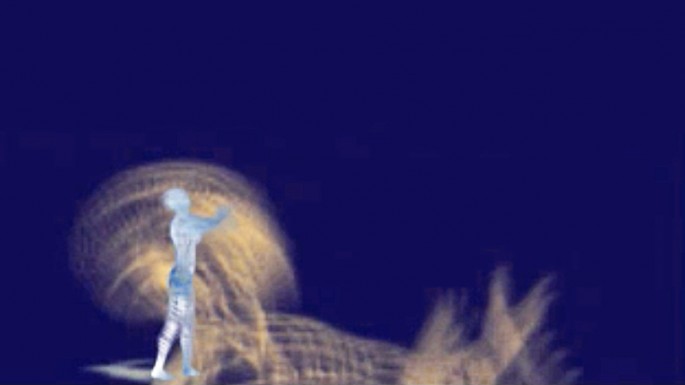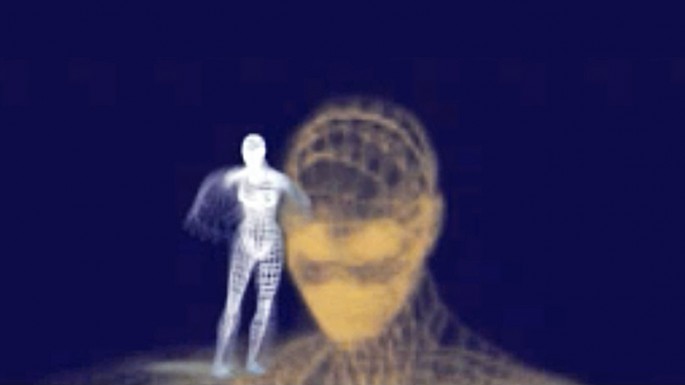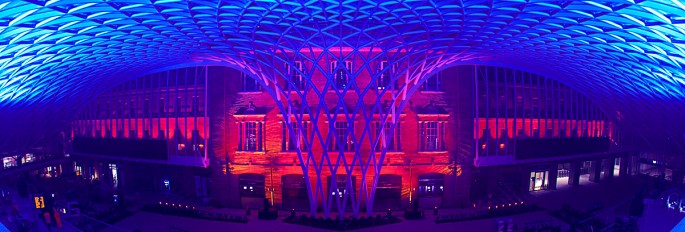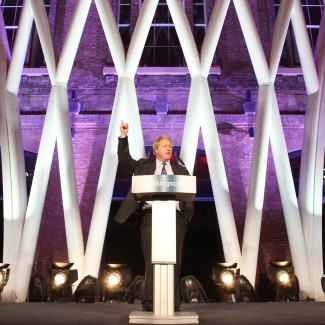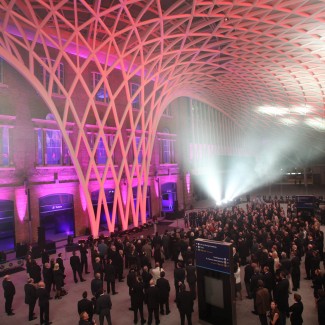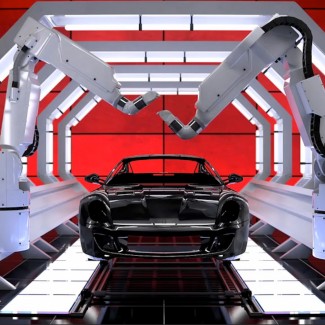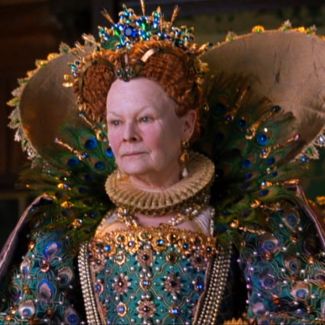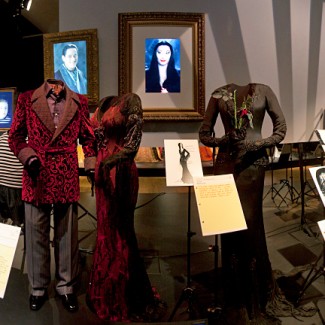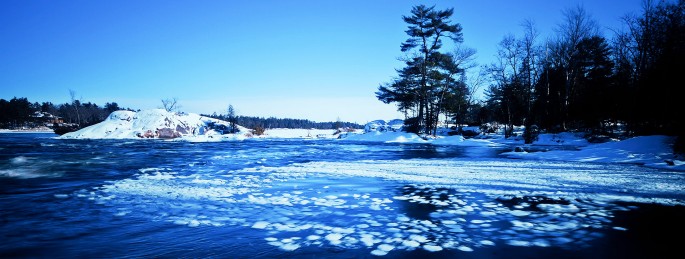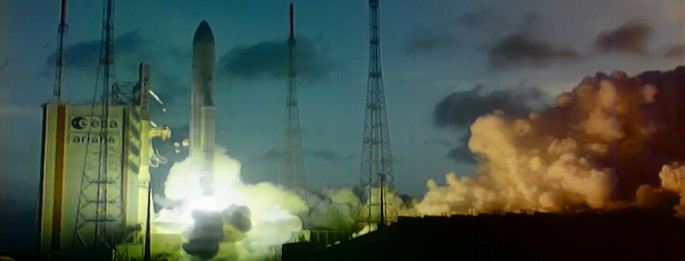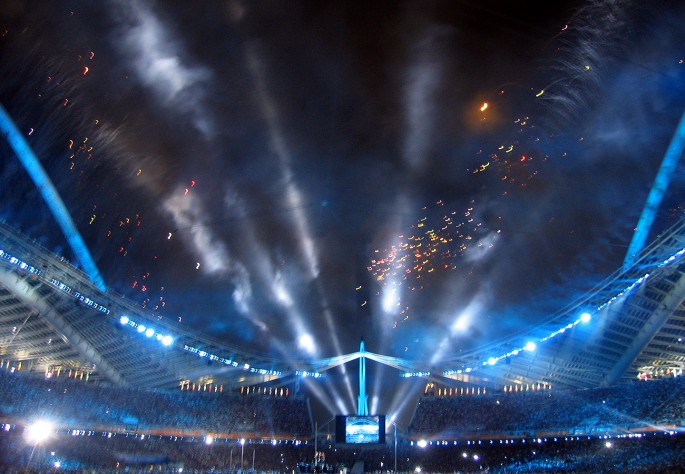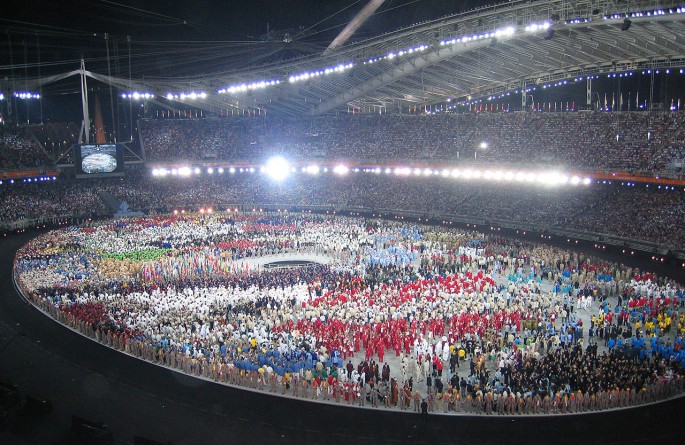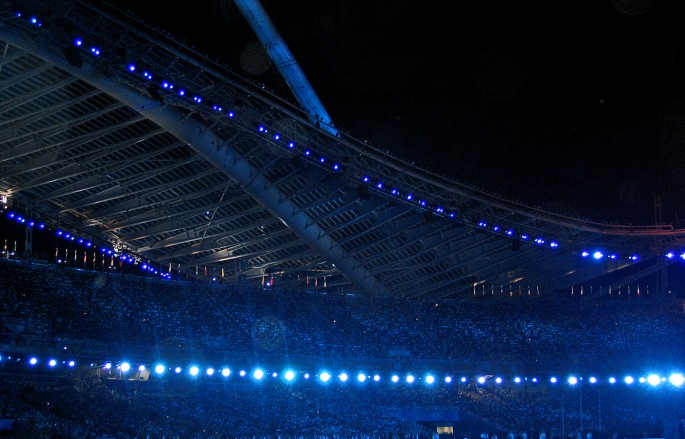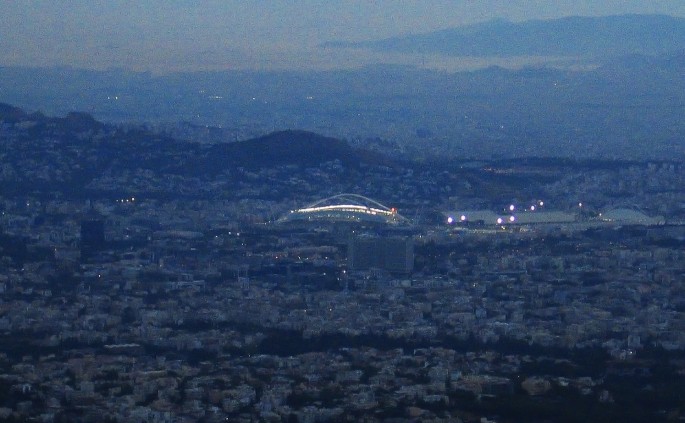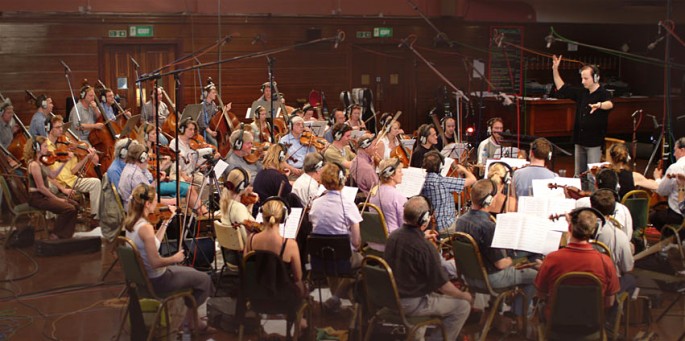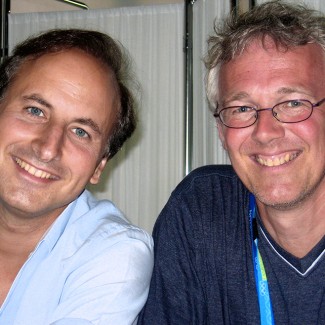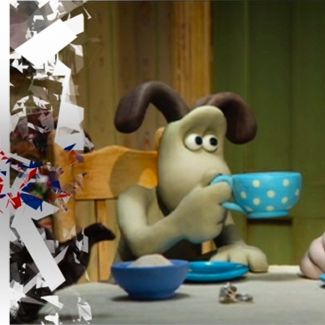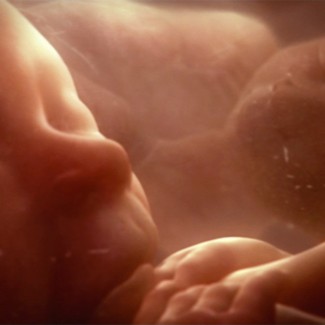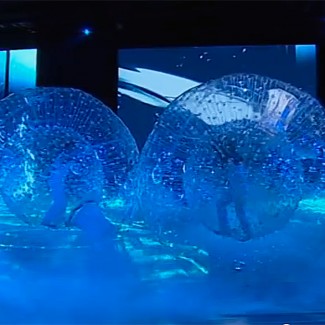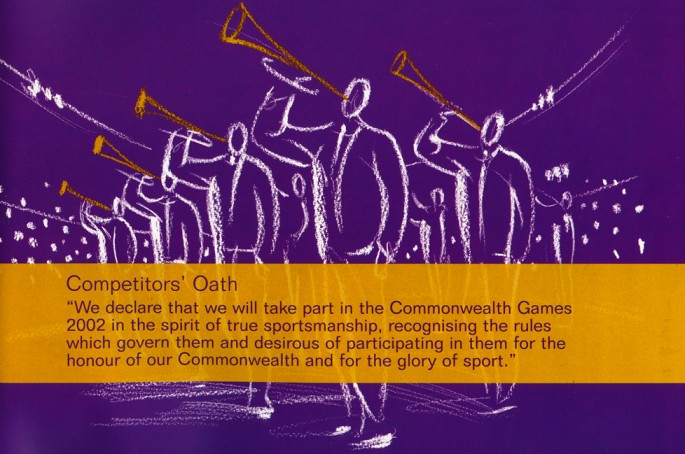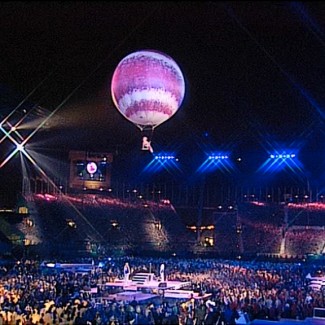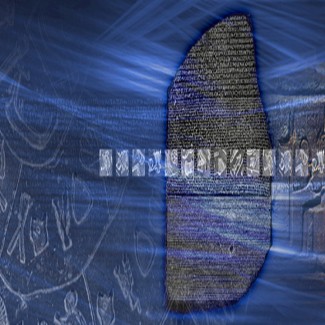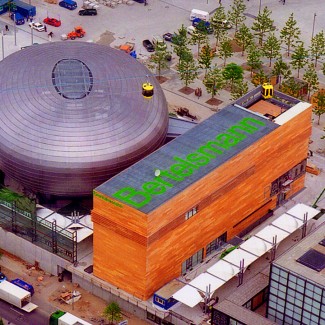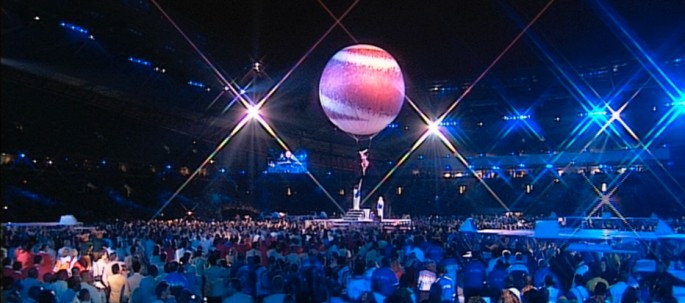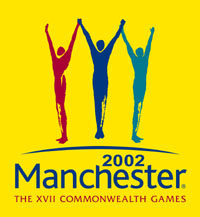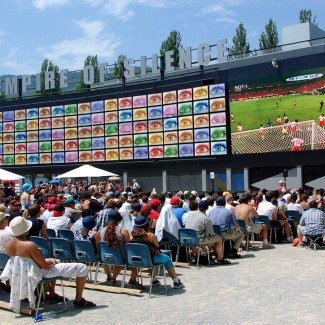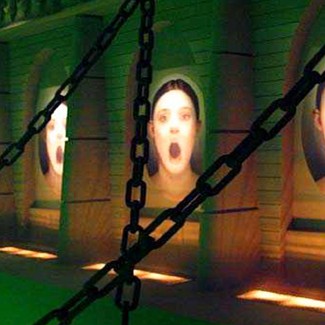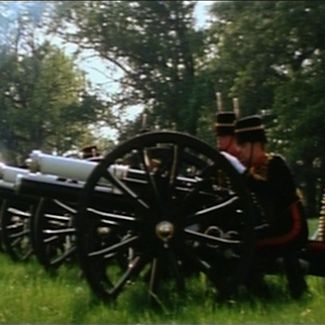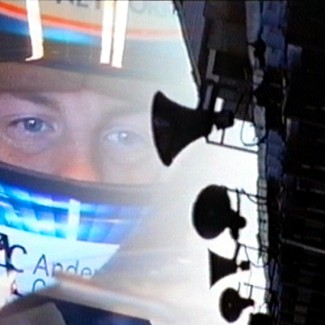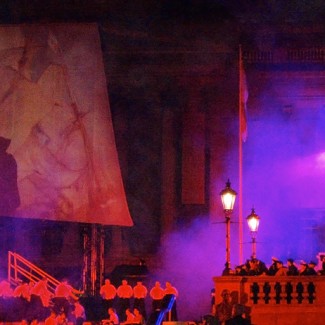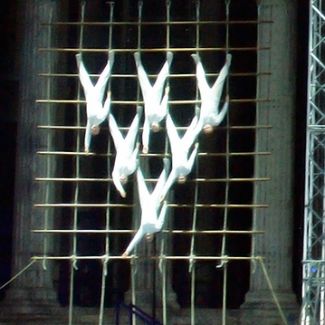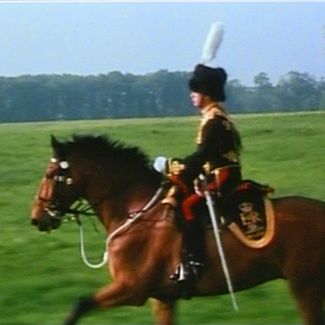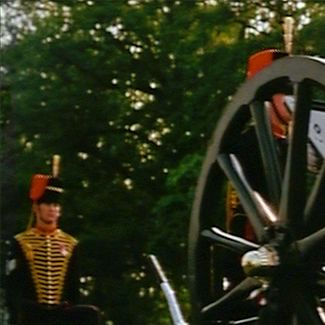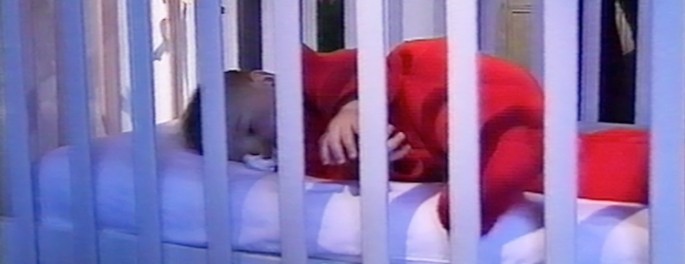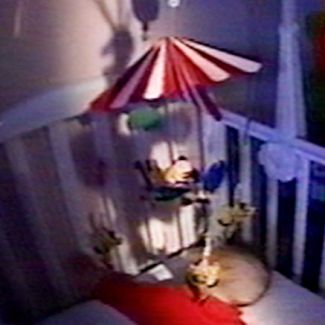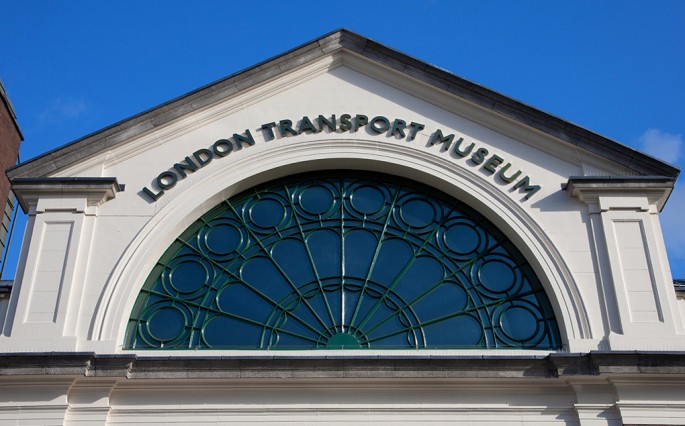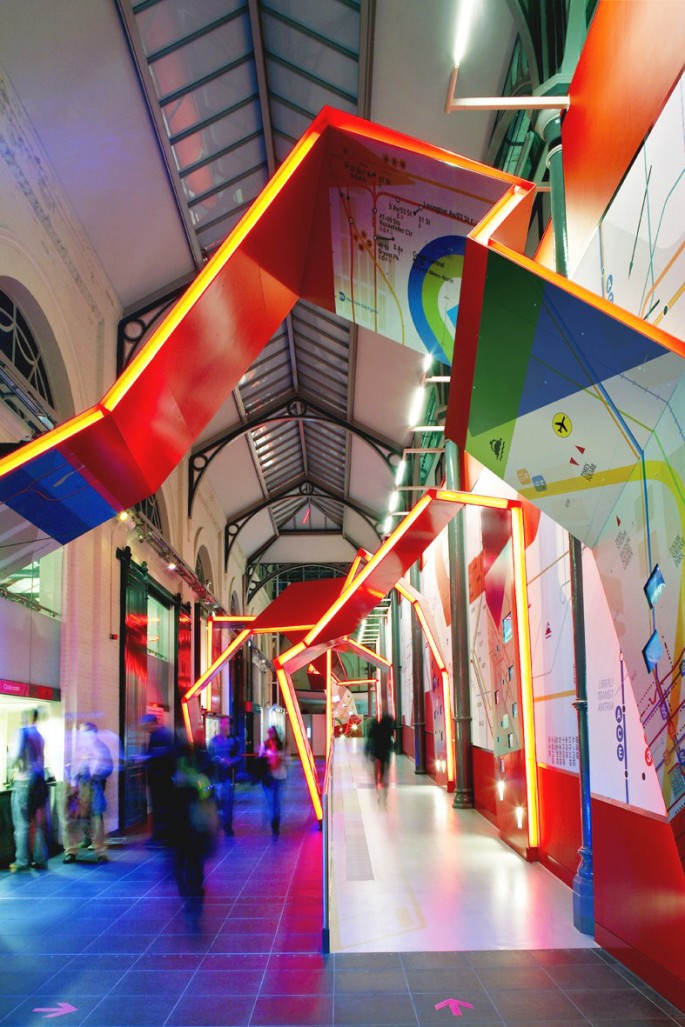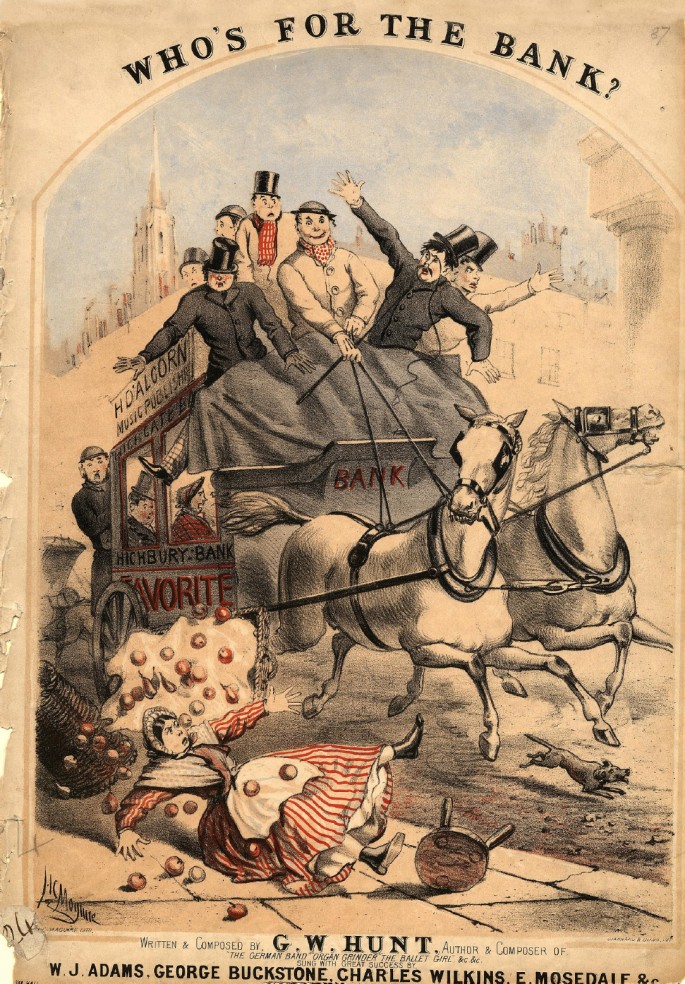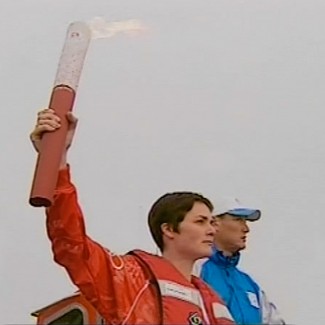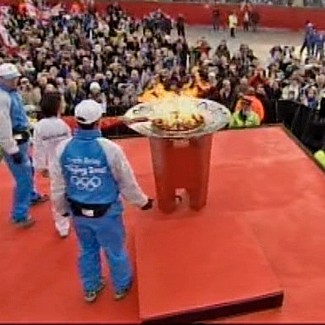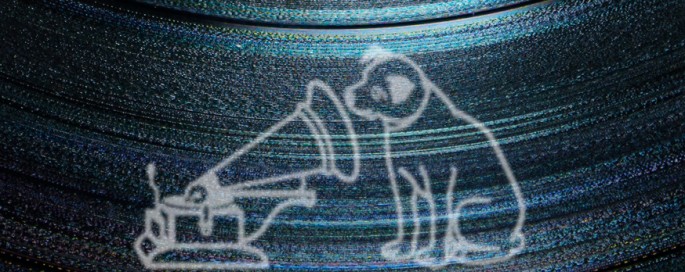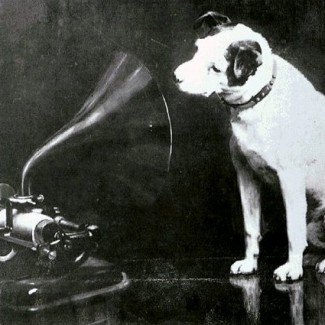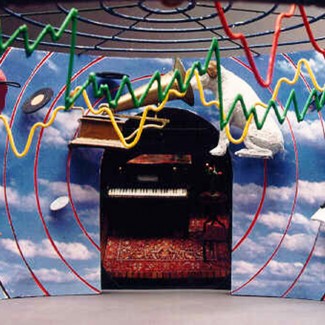Berlin Ballet
An avant-garde dance piece choreographed
by Antonio Gomes and commissioned by Bertelsmann for performance in Berlin.
The opening to the work was a massive visual backdrop featuring two dancers. They dance to a symphonic score performed by the Royal Philharmonic Orchestra.
The piece continued with a fusion of fractal video images, motion controlled video samples (of the dancers), plus a live dance troupe.
Solo operatic voices were combined with 60 piece choir, orchestra and urban/ethnic percussion.
A short video of part of the recording sessions at Abbey Road can be viewed below.
Credits
Choreography – Antonio Gomes
Opening Film Directed by Smike
Produced by Simon Lethbridge
Performed by The Royal Philharmonic Orchestra
Conducted by Jill Jarman
Choir – The Joyful Company of Singers
Choirmaster – Peter Broadbent
Solo Soprano – Debra Skeen
Solo Tenor – Brian Miles
Recorded at Abbey Road Studio 1
I.O.C. Olympic Museum
Finale sequence for the International Olympic Committee’s award winning permanent museum in Lausanne, Switzerland.
An emotive multi-screen presentation featuring the “triumphs and defeats” witnessed in Olympic Games past and present.
Credits
Production Company – Centre Screen
Executive Producer – Dave Postlethwaite
Senior Producer – Lisa O’Neill
Original Music – Julian Scott
Sound Design – Peter Key
Kings Cross Official Opening
The official opening ceremony was the culmination of a £500 Million project conceived in 1997. Architects John McAslan and Partners delivered a stunning webbed arch spanning the station concourse receiving the prestigious New London Architecture ”Overall Winner” award.
The ceremony, created by Unspun for Network Rail, was hosted by Kevin McCloud along with Boris Johnson, Justine Greening the transport secretary, David Higgins Network Rail chief executive and David Partridge of Kings Cross Central.
The event featured a soundscape scored using sounds captured from the day to day activities of the railway network. This evolved into a musical work based of the rhythms of the track and sounds of the trains reflected in an orchestral setting.
The finale was a Son et Lumiere across the 7500 square metre western concourse highlighting the shapes and reflections of the new design. The 20 metre high latticework “funnel” constructed of steel and glass was the centre piece for lighting designed by Glyn Peregrine.
The soundtrack was realised using a multi-channel and multi-space sound system allowing the audio to be fine-tuned to the environment as well as providing sound quality of cinematic proportions. There was also a documentary of the project produced by Wilder.
Credits
Photographs courtesy of PRG and Robert Alge
Creative Director – Robert Alge
Lighting Design – Glyn Peregrine
Executive Director – Chris Laue for Unspun
Producer – Luke Thomas
Music Composition and Orchestration – Julian Scott
Sound Design – Staf Rowley for Dimension Audio
Lighting Programmer – Jim Beagley
Facilities and Lighting – PRG
Kings Cross documentary director – Ed Mcgown for Wilder
Ferrari
Ferrari World, the world’s largest indoor themed park opened in November 2010. The structure was designed by Benoy Architects and the visitor experience created by Jack Rouse Associates of Cincinatti.
Julian conceived and scored the music for the centre-piece Made in Marenello. A dynamic dark ride through a virtual recreation of the design and manufacturing process of a Ferrari 550. The initial ideas were presented to Ferrari in Maranello and approved by Luca di Montezemolo.
The score, performed by the Royal Philharmonic Orchestra, is synchronised to play from both moving passenger vehicles and static surround sound installations. This enables a seamless narrative to journey with the audience yet at the same time deliver the full surround cinematic experience.
The orchestra, recorded in Studio 1 Abbey Road London, was conducted by Jill Jarman. Sound recordings of Ferrari cars at special sessions were integrated within the work and a robotic painting sequence was “choreographed” to the music along with filming at the Ferrari factory in Maranello, Italy.
Julian worked closely with the ride technicians and location sound design team to ensure the recordings would match the environment and synchronise with the movement and media elements.
Credits
Performed by The Royal Philharmonic Orchestra, Joyful Company of Singers
Leader and Violin – Clio Gould playing the Rutson Stradivarius of 1694
Conductor – Jill Jarman
Choir Director – Peter Broadbent
Scoring Engineer – James Collins
Music Composition/Production – Julian Scott
Video Director – Kevin McKiernan
Producer – Heidi Snelgrove for Centre Screen
Production Assistant – Alicia Gustave
Executive Director – Dave Postlethwaite
Executive Producer – Jeff Kraemer for Jack Rouse Associates
Ride Sound Design – Peter Key
Ride Technology – Philip Hartley
Hollywood Costume
Hollywood Costume – V&A London, The Academy Museum Los Angeles, International Tour
Hollywood Costume is a ground breaking exhibition exploring the central role costume design plays in cinema storytelling. Conceived by Oscar nominated Deborah Landis and researched over a five year period the record breaking show was was sold out for the duration of it’s six month London run with over 265,000 visitors. There followed an international tour due to conclude at the Academy Museum in Los Angeles.
The exhibition spread over three entire galleries featured highly innovative design from London agency Casson Mann under the creative direction of Roger Mann.
The soundtrack to the exhibition had a number of challenges. Deborah didn’t want background music but a captivating score reflecting the emotions of blockbuster movies across the decades.
Visual media was produced with a short loop duration to inform a moving audience however due to the open and reflective nature of the galleries a repetitive theme of short duration could have detracted from the experience.
The solution was a score that evolved over a number of minutes yet had a tempo framework allowing the visual media to repeat yet remain in synchronization with the music. The galleries were also divided into four zones with synchronous but varying orchestrations evolving as the visitor passed through the exhibits moving from romantic Hollywood via action percussion to baroque for the historical sections. This removed the usual audio clashes that occur when numerous soundtracks are played in an open space.
A specially designed sound system with studio quality monitors was installed across the three galleries. In each space the music was mixed on the system to match the gallery acoustics prior to transfer to the show system. This enabled a more theatre like sound quality to be achieved.
In the second gallery where there were a number of interview recordings the soundtrack had neutral mixes in the busier areas morphing into stronger movements where a more dynamic presentation suited. Although there was a common theme across the whole exhibition the design of the music created a linear duration of 90 minutes so the visitor could enjoy an extended view of the displays without repetitive audio content.
An example of how the music was scored to evolve across a gallery can be heard on the audio player (Hollywood Costume transitions). This illustrates how the orchestration seamlessly evolves between zones without clashes.
Credits
Pictures courtesy of Keith Lodwick
Conceived and curated by Deborah Nadoolman Landis
Guest Curator – Sir Christopher Frayling
V&A Curator – Keith Lodwick
Producer – Sue Joly
Creative Direction – Roger Mann for Casson Mann
Associate Designer – Gary Shelley
Design – Virna Di Schiavi
Music Concept/Composition – Julian Scott
Orchestrations – Jill Jarman
Video Production – Picture Production Company
Software Production – Squint Opera
Lighting – DHA Design Services
Systems Design – Graeme Bunyan for Sysco A/V
The Frozen Forest
A short film from City Pines Films shot in Ontario, Canada. Locations include Burleigh Falls and the dense forest area north of Fenelon Falls.
Stunning time-lapse cinematography, shot in temperatures of -20 and below, by director Ben Lean.
High Definition and Standard Definition versions can be viewed in the players, also more tracks with a winter theme, composed by Julian, can be heard below.
Credits:
Filmed and edited by Ben Lean
Yahsat
Yahsat 1a, launched by Al Yah Satellite Communications Company of Abu Dhabi, as part of the regions first multi-purpose satellite system. Constructed by EADS Astrium and Thales Alenia Space Y1A was launched at the Guiana Space Centre in French Guiana atop an Ariane 5 ECA rocket.
The documentary charts the progress from initial concepts through to design, construction and launch.
In addition to providing music for the programme Julian provided the sound design and broadcast mixes.
Listen to the power of the Ariane 5 leaving the launch pad in T minus 10, with further extracts from the documentary and additional music below.
Credits:
Director – Rob Butcher
Editor – Lee Buers
Producer – Clare Gibson
Production Company – Wilder Films
Original Music, Sound Design/Mix – Julian Scott
Olympic Games
Opening and Closing Ceremonies
The Opening and Closing Ceremonies of the Athens 2004 Olympic Games captured a global TV audience in excess of 4 billion.
Julian worked on the project over an 18 month period collaborating with Yorghos Koumendakis (co-creator of the Ceremonies concept and Director of music) to produce the opening and closing soundtracks.
The Olympic ceremonies, realised by Jack Morton Public Events under the direction of David Zolkwer, were the first to be produced by a non- indigenous company. They assembled a team from across the globe to assist Greece in creating what was universally acknowledged as “a triumph”
Advanced technologies were utilized by Adam Wildi (Senior Technical Director) to bring an ambitious creative dream to a world stage.
Major elements included flooding the Olympic Stadium with half a million gallons of water, a fiery comet shooting from the sky and igniting the Olympic Rings, a 22-ton, 60-foot cycladic head emerging from the “sea”, splitting and re-splitting to reveal two statues, then fragmenting into 18 sections depicting the Greek islands.
Further details can be viewed by clicking the links below:
Olympic Games case study
Five hours of music, two symphony orchestras, two Greek popular orchestras, numerous choirs, ethnic groups and solo performers…
The Opening and Closing Ceremonies of the Athens 2004 Olympic Games captured a global TV audience in excess of 4 billion.
Julian led the project for an 18 month period from June 2003 utilizing a production technique and workflow that could accomodate a continually changing brief, yet still deliver an Opening and Closing Ceremony soundtrack compatible with both a Greek music recording legacy and the requirements of a worldwide broadcast.
The 2004 ceremonies were the first to be produced by a non- indigenous company. Jack Morton Public Events, the producers, assembled a team from across the globe to assist Greece in creating what was universally acknowledged as “a triumph”. At the time of the Opening Ceremony the core production team numbered 430.
State of the art technology was utilized throughout the production, from intitial music preparation through to major structural engineering, creating representions of both ancient and modern Greece, including flooding the Olympic Stadium, a 60-foot high cycladic head emerging from the resulting “sea”, splitting to reveal two statues, then fragmenting into 18 sections depicting the Greek islands.
Despite the huge scale of the event the music still was able to visit areas of both intimacy and reflection.
All the recordings were made directly to disc using Apple’s Logic Pro with Metric Halo audio interfaces. We utilized 4 systems to enable recordings to be made concurrently and any system could instantly be set up to preview or work on a mix. The maximum number of track used in a mix was 255 for one of the more complicated arrangements.
Wherever possible the recordings were made in sections (separate parts of the orchestra playing at different times) to enable there to be flexibility – this allowed the creative development of the ceremonies to continue after the recordings had been made, by offering the capability to re-arrange the music as well as edit the duration.
The recording venues were mostly in Athens, with the Megaron (Athens Concert Hall) and Sierra Studios providing the main facilities.
Mixing, was carried out in Sound Affects studios in the UK, at a specially constructed studio in Jack Morton’s Athens production office, and also by Paul Stefanidis (who handled a lot of the recording and mixing duties) in his own facilities.
Harbeth professional monitoring loudspeakers were used throughout the project in different studios to ensure consistency.
We recorded the ERT symphony orchestra in the main concert hall in Athens and made further recordings with the Royal Philharmonic Orchestra in Watford, England. All orchestral rehearsals and recordings were under the baton of top Greek conductor Miltos Logiadis.
As well as conventional orchestral recordings we made numerous recordings of Greek instruments including Lyras, Gaidas, Ouds, Santours, Lutes, and of course Bouzoukis – 50 of them!
Further details can be viewed by clicking the links below:
Credits
Artistic Director – Dimitris Papaioannou
Director of Public Events Jack Morton Worldwide – David Zolkwer
Music Concept Creator – Yorghos Koumendakis
Music Associate – Maria Metaxaki
Video Director – Athina Tsangari
Lighting – Eleftheria Deko, Robert A. Dickinson
Choreography – Angeliki Stellatou
Conductor – Miltos Logiadis
Executive Producer – Andrew Walsh
Music Department:
Music, Music Production – Julian Scott
Associate Producer – Marcus Dillistone
Coordinator – Vassilia Katsani
Soundtrack Production Supervisor – Paul Stephanidis
Recording Engineer – Dick Lewzey
Great Britain
The flagship film for the UK Trade and Industry and British Council “Great Britain” campaign launched by Prime Minister David Cameron.
The campaign promotes The United Kingdom internationally and raises awareness of the UK’s strengths in the arts and education. Since launch it has delivered a direct return to the British economy in excess of £1Bn. The film has been presented across the globe from China to the United States of America as both single and large scale six screen presentations.
The six screen version, along with additional music from the presentation, can be viewed below.
Credits
Director – Julian Pearson, Leafstorm
Editor – Matt Melrose
Executive Direction – Maurice Fleming
Production – Rebecca Bryant
Production Company – Shelton Fleming
Sound Design/Original Music – Julian Scott
Vocals and Solo Violin – Jessica Watson
Guitar and Bass – Dominic Scott
Toyota – London
The entire length of the Excel centre equivalent to two and a half football pitches was transformed by Jack Morton into a performance space which featured a race track, skating circuit, performance areas, motor-show scale vehicle exhibition and West End theatrical stage for an evening musical. The event under the creative direction of Kim Gavin featured 100 cast, skaters, acrobats, singers, percussionists, mime artists, 50 vehicles and the Toyota Formula 1 team and drivers Timo Glock and Jarno Trulli.
The audience were taken on a journey through 45 years of Toyota in Europe told through human stories, dance, action sequences and archive footage. There were 14 car reveals, Formula 1 cars doing doughnuts and a 30 piece drum band.
A stadium scale sound system provided surround sound. The tracks were mixed and edited on site with changes being made to tempos and durations as the event choreography was fine-tuned.
“Having received feedback from many retailers and attendees, it’s clear that we really inspired and motivated our guests. It was a world-class experience.” Toyota marketing director, Paul Van der Burgh.
Credits
Event Production – Jack Morton Worldwide
Creative Director – Kim Gavin
Executive Producer – Adrian Power
Executive Producer – Jim Donald
Producer – Miles Platt
Producer – Emma Fitzgerald
Original Music – Julian Scott
Video Director London – Sharon Stansfield
Video Director London – Jan Ostrowski
Video Director Europe – Janos Deri
Technical Director – Chuck Crampton
Sound Design – Paul Keating for Delta Sound
Commonwealth Games study
The Commonwealth Games was both the largest and most successful sporting event to be hosted by the United Kingdom in recent history. A contributory factor to their success were the Opening and closing ceremonies.
Julian was commissioned, by artistic director David Zolkwer, to score some of the key moments including the centerpiece arrival of the baton.
The Royal Philharmonic Orchestra and The Joyful Company of Singers were recorded at the Coliseum in London. Unusually the sections of the orchestra and choir were recorded over a number of separate sessions, this was to ensure that maximum flexibility for on-site mixing and editing was maintained and to allow for last minute changes.
As well as providing a suite of symphonic music the producers asked Julian to co-ordinate the presentation and mixing of all the diverse musical elements that comprised the shows.
These varied from Gamelan to Classical and Marches to Club Grooves.
A temporary multitrack studio was installed within the stadium complex and from here broadcast and live mixes were created with changes being made right up to the final night.
The studio was connected to the main stadium system as well as to the broadcast hubs so the music was fine tuned for both live audience and the one billion listeners worldwide.
Further audio clips can be heard on the Commonwealth Games project page
Read the Metric Halo press release about Julian’s sound production for the games.
Planet ‘M’
Planet ‘M’, commissioned by Bertelsmann for the 2000 World Expo, is a multimedia installation charting the history of
media.
The multifaceted soundtrack is a fusion of ancient and modern sounds, including; voices, ethnic instruments, a symphony orchestra, electronic sound images, effects, and archived audio. All elements were crafted to excite, inspire, and to illustrate an extraordinary history.
The main theme received such an enthusiastic reception from the public (and Bertelsmann’s’ directors) that it was adopted as a corporate identity and public face for the entertainment giant. This success resulted in further commissions across various media.
Credits:
Production Company – Triad, Berlin
Directed and Produced by Nikolaus Hafermaas and Lutz Engelke
Producer – Katharina Albrecht-Stadler
Image Concept and Production – First Image
Original Music – Julian Scott
Conductor, Orchestrations – Jill Jarman
Performed by The Royal Philharmonic Orchestra
Choir – The Joyful Company of Singers
Solo Soprano – Debra Skeen
Commonwealth Games
A music suite for the centerpiece of the Commonwealth Games ceremony. The full symphonic complement of the Royal Philharmonic Orchestra was engaged to realise the dramatic score.
The piece starts in dramatic fashion with the baton entering the stadium carried by an aerialist suspended by balloon. Additional pieces covered the official opening of the games, and the sensational stadium light shows.
The soundtracks were 24 track surround mixes and as well as making a stunning impact in the stadium were broadcast around the world to a billion-strong TV audience.
In addition to scoring a suite of symphonic music the producers commissioned Julian to co-ordinate the presentation and mixing of the entire opening and closing ceremonies. See Case study
Credits
Event Production – Jack Morton Worldwide
Artistic Director – David Zolkwer
Executive Producer – Julie Brooks
Choreography – Arlene Philips
Choreography – Karen Bruce
Choreography – George May
Lighting Design – Andrew Bridge
Lighting Design – Andrew Doig
Technical Director – Adrian Cook-Radmore
Sound – Paul Keating
Musical Supervisor – Max Lambert
Original Music and Event Soundtrack Production – Julian Scott
Performed by The Royal Philharmonic Orchestra
Conductor – Jill Jarman
Choir – Joyful Company of Singers
Choirmaster – Peter Broadbent
Solo Soprano – Debra Skeen
Empire of Silence Swiss Expo
A major pavilion at Swiss Expo 2002, “The Empire of Silence” evokes a battle between the forces of silence and communication.
Six interlinked theatres provided the backdrop/setting to an exciting dark adventure, culminating in the destruction of the Empire.
Over 500 effects were designed and incorporated in the innovative and contemporary score. A huge networked sound system with 50 channels of computer controlled audio was incorporated into a warehouse-sized building constructed especially for the event.
The soundtrack, central to the show, drove the action.
The pavilion was recognized as one of the most successful and visited installations of the whole Expo being voted “Best Pavilion” by the public and winning “Live Event of the Year” at the AV awards.
Live switched the experience from a- v, ‘a traditional Expo medium’, to live theatre as a way of underlining the moment when silence becomes scary. ‘The unifying medium that runs through it all is sound,’ says Newman, ‘We worked with Julian Scott, one of the best visitor attraction composers in Britain, to create the soundtrack.’
Credits
Creative Director – Martin Newman
Producer – Pip Campbell for Live
Project Manager – Ginette Pernet for Nussli
Technical Direction – Adam Wildi
Design – Steve Austen-Brown for Pitch
Lighting Design – Andy Grant
Soundtrack Concept and Original Music – Julian Scott
Sound Design – Kevin Swain for Dimension Audio
A/V Provision – Creative Technology
Show Control – Stage One
Boeing
For the Dreamliner 787 launch Julian was commissioned by Boeing to score music for a series of short films featuring the new aircraft.
Credits:
Director – Amanda Worsley
The Troop Film
The Troop film sets out to capture the sheer power and grace of The King’s Troop royal horse artillery. Award winning director Marcus Dillistone, noted for his demanding sound requirements, commissioned Julian to score the film and also oversee the location and post production sound.
As well as recording during filming, the entire King’s Troop were made available for a special sound shoot. Microphones were strapped to gun carriages, horses and riders, and for that final bit of realism 12 tons of horse and gun were galloped past the sound recordist with inches to spare.
Unlike nearly all modern features the Troops soundtrack was created from the actual sounds of the Troop with no artificial processing. The music score was crafted to allow space for these fx resulting in a powerful dynamic soundscape to complement stunning cinematography.
Williams Formula 1
A television commercial and short documentary featuring the Williams Formula 1 team.
As well as special access to the factory and technical facilities, a special test session was set up at the Nogaro racing circuit in the South of France. Prior to an official Formula 1 test session two race cars, along with drivers Jenson Button and Juan Pablo Montoya, were made available, exclusively, for the film production.
Microphones were mounted on the cars and in the pit garages as well as around the circuit. The captured sounds were used to create rhythm tracks for use in the score.
Credits:
Creative Director – Tom Griffin
Video Director – Charlie Phillips
Editor – Jan Ostrowski
Original Music, Sound Design and Mix – Julian Scott
Trafalgar 200
A composition specially commissioned for the Trafalgar Bicentennial year and given a Royal performance with an audience of 10,000 in London’s iconic Trafalgar Square.
The work celebrates Britain’s maritime heritage covering the 200 years from Nelson to the present day.
Trafalgar Square 200 was the grand finale to a comprehensive series of major events across the globe commemorating the bicentenary of the Battle of Trafalgar and Nelson’s death. The event was broadcast live round the world and featured on the BBC’s prime evening schedule in the UK.
The theatrical action, as well as capturing the historic context of the Battle of Trafalgar, encompassed the architecture of the square itself. Royal Marines fast roped down the face of the National Gallery, Free-runners scaled the column and Tameside unit performed an acrobatic window ladder display.
The finale included performances by the choir of The Royal Grammar School, Newcastle and operatic soloists Susan Jiwey and Alex Pidgen.
Below you can view highlights from the BBC’s coverage of the event, hear the dramatic and poignant story of H.M.S. Hood and the Bismarck the musical setting of the Battle of Trafalgar with the Finale “Oh for the Sea”
Trafalgar Square 200 was directed by Robert Alge for Innovision.
Credits
Photographs – Vassilia Katsani
Event organisers – Trafalgar 200
Event producers – Innovision
Executive producer – Will Glendinning
Writer – Stuart Blake
Producer and Show Director – Robert Alge
Choreography – Wanda Rokiki, Rocky Smith, Gina Martinez
Lighting Design – Durham Marenghi
Sound Design – Paul Keating at Delta Sound
Voice recording – Adrian Sear at Soundtracks
Narrator (Nelson) – Terence Wilton
Choir arrangements and orchestral consultant – Jill Jarman
Choir director and conductor – Neal Parker
Solo Soprano – Susan Jiwey
Solo Tenor – Alex Pidgen
Lyrics (“Oh for the Sea”) – Julian Scott, Dominic Scott
Soundtrack conceived, composed and produced by Julian Scott
The Troop
The Troop is a 35mm CinemaScope production which had a Royal Premiere at BAFTA. It has also been presented to Her Majesty the Queen at a special showing at Windsor Castle.
The film was produced and directed by award winning director Marcus Dillistone, and shot by Oscar Nominee Alex Thomson BSC. The Troop has a powerful, epic soundtrack.
Julian recorded and produced many of the audio effects used within the film along with composition and production of the music score, to find out more view the case study.
Credits
Narration – Sir John Mills
Music Composition and Production – Julian Scott
Performed by The Royal Philharmonic Orchestra
Conductor and Orchestrations – Jill Jarman
Solo Soprano – Debra Skeen
Recorded and Mixed by Dick Lewzey at CTS
Written and Directed by Marcus Dillistone
Cinematography – Alex Thompson
Key Grip – Dennis Fraser
Edited by Roger Guertin
Produced by Glory Film Co
Associate Producer – Paul-Anthony Violet
Nannies From Hell
A major network TV documentary exposing the shocking subject of nannies and child abuse.
The orchestral score added a sometimes haunting quality to the story, and was described by ITVs’ head of documentaries as “…bringing film quality scoring to television.”
As well as attracting one of the years’ highest viewing figures for a UK documentary, the 60 minute film has been distributed around the world.
Credits:
Directed by Jessica Fowle
Original Music – Julian Scott
London Transport Museum
Julian was commissioned by the London Transport Museum to provide a complete audio identity across the entire museum following a £22 million refurbishment and extension.
Individual exhibits were brought to life through dramatic audio “plays” performed by a large cast of actors, with specially composed soundscapes providing atmospheres reflecting the last three centuries. Songs from the 19th Century were re-arranged and recorded to add colour to the period displays.
Original recordings were made of many of the museum’s unique vehicles and trains and access granted to hidden parts of the underground to capture unique sounds which were then used as rhythmical elements within the compositions.
A full surround sound system was installed across the galleries and within the exhibits to allow high quality and focused playback of the numerous soundtracks.
A number of soundtracks can be reviewed in the audio player.
Audio Notes:
1. Entrance – a piece to bridge the environments of the street and the galleries
2. 20th Century – a multichannel soundscape covering the 20th Century Galleries
3. 19th Century – a multichannel soundscape covering the 19th Century Galleries
4. Jolly Young Waterman – by Charles Dibdin, was written for his opera The Waterman and is used in the Thames Story in the 19th Century Gallery
5. Who’s For The Bank – by GW Hunt a music hall song from 1865 played in the horse transport section
6. A Bricklayer’s conversation – recreated for the Cut and Cover model depicting construction of The Underground
7. From The Horses Mouth – an amusing “conversation” between two pairs of horses from the buses and the trams, each pair talks disparagingly about the other and pass bitchy comments back over their shoulders.
Credits
Design – RAA
Design – Conran
Project Management – Fraser Randal
Project Management – Kate Petty
Head of Systems & Infrastructure – Rob Lansdown
Audio Design – Martin Pilton
Solo Tenor – Alex Pidgin (Jolly Young Waterman)
Vocalist – Roger Brasier (Who’s For The Bank)
Piano – Jill Jarman
Writer – Nick Wilton
Picture Credits:
London Transport Museum
Conran Design
Peter Cook RAA
Olympic Torch
When the Olympic Torch visited the United Kingdom on it’s journey to the Beijing Olympics Julian was asked to score the official music for the lighting ceremony in London.
The music was played at a specially constructed stage by the O2 arena and broadcast on a live BBC TV special.
The torchbearers were Ellen MacArthur, Danny Crates, Theo Walcott and Dame Kelly Holmes.
Credits
Event produced by Robert Alge for Innovision
Original Music – Julian Scott
Solo Soprano – Debra Skeen
Rhythm Programming – Mikey J
Ajyal Film Festival
Closing ceremony of the International Ajyal Film Festival.
A circus like performance featuring aerialists, trapeze artists and fire-eaters on a grand scale, closed the five day event that had featured aspiring and established directors from across the region.
Credits
Event Production – Unspun
Artistic Director – Steve Boyd
Executive Director – Chris Laue
Senior Producer – Diana Henry
Production Co-ordinator – Rob Anderson
Original Music and Soundtrack Production – Julian Scott
Additional themes, Eastern music research – Jill Jarman
Vocals and Keyboards – Jill Jarman
Vocals and Violin – Jessica Watson
Vocals – Dominic Scott
Vocals and Bass – Harry Pearce
Drums – Joey Lyon
EMI Music 100
Music 100 was large scale interactive public exhibition tracing the history of sound and marking the Centenary of EMI. Technologies explored ranged from the first wax cylinders to digital multit-racks and surround sound.
The exhibition was opened by Diana Ross at Gallery West in docklands, London with proceeds donated to the Music Sound Federation.
As well as composing a number of original works, including an introductory piece “The Drum” Julian also worked closely with the curators in the selection and preparation of hundreds of audio archives to represent the history of recorded sound and music. Editing, production and technical management was provided to ensure a dynamic cohesive presentation of the material.
Close co-operation was maintained with the designers and installers of the complex replay systems with particular attention being given to how multiple sound systems interacted over the total exhibition space.
In excess of 300 individual soundtracks were produced by Julian representing the sonic highlights of the past century. These included extracts as diverse as “Soldiers of the Queen” from 1898, Caruso the opera singer, King George V, and an amateur recording of the Quarry Men (later known as The Beatles) at a church fete on 6th July 1957 the day John Lennon met Paul McCartney.
There were also interactive multitrack and surround sound demonstrations recreating the inner workings of a top recording studio.
Listen to The Drum and original composition commissioned for the exhibition.
Credits
Music 100 was produced by Sue Joly for Purchasepoint
Original Music, Soundtrack Research and Production – Julian Scott
Director of External Affairs EMI – David Hughes
Time
Based on the movement and sound of an analogue stopwatch this piece was initially created as an installation for electronics giant Philips.
The original soundtrack been evolved with the addition of highly contemporary drum rhythms.
City of the Silenced
Created as part of a series of audio landscapes for the Empire of Silence pavillion/experience at the last Swiss Expo.
Desert
Exotic desert landscape, ethnic instruments combined with a string orchestra and effects. Part of the album Environments.
Earth
Originally scored for the Earth Galleries at the Natural History Museum, London.
An atmospheric piece featuring solo violin and voice.
Electricity
High impact fusion of Fx and powerful beats. Commissioned for the launch of a new high technology centre for Toyota in the Middle East.
Fog
Atmospheric setting of Charles Dicken’s Bleak House.
Performed by Joss Ackland and commissioned for a London theatrical production at the Royal Festival Hall.
Formula 1
Produced for the Williams Formula 1 team.
Sounds were captured at a full F1 test session over two days and supplemented by location recordings at the UK factory then integrated to create a multi layered score for a video documentary.
Ice Fields
Full orchestra, solo boy treble, soprano and choir combine with effects to give a haunting soundscape moving from calm to grand vistas then solitude.
Mechanical Power and Transport
Commissioned by the London Transport Museum, extensive recordings were made of their historic vehicleand train collections.
Further unique sounds were recorded in closed off sections of the London underground to create an unusual and stimulating soundtrack for the galleries.
Rain Forest
Original sound effects recorded in the Rain Forest by Julian are combined with ethnic instruments. The piece features the voice of Juwon Ogungbe.
Satanic Mills
Special access was provided to Birmingham Museum’s historic collection. Extensive recordings were made of numerous belt driven machines with great care taken to bring out the
nuances of their operation. The multilayered soundtrack is a journey into the machines.
Secret War
A full orchestra and original score combined with specially produced Fx provides an atmospheric setting to the start of the Imperial War Museum’s Secret War gallery, a permanent
exhibition in London.
Space
Large orchestra, voices and Fx create an atmospheric and etheral Audio Landscape. Elements originally prepared for the British National Space Centre then developed and remixed
for commercial release.
Subterranean
Foleyed Fx and natural recordings combined to create a subterranean atmosphere, the addition of blown bottles and soft brass provides a period feel.
Produced for Kew Bridge Steam Museum.
Technology
Intricate sound design, constantly evolving rhythms and specially created Fx portray a journey through the internet. Originally conceived and created for RBS’s software division then developed and remixed for commercial release.
The Advent of Steam
An audio landscape depicting the transformation steam had on industry and transport. A surround sound installation with projected visuals in Birmingham’s award winning Think Tank Science Museum.
The Machine
Originally part of the soundtrack for a full scale theatrical production performed at the Alton Towers theme park. All the Fx/sounds were created from the ground up. The theatrical mix was three dimensional surround presented over eight channels.
Victorian Soundscape
An audio creation of Victorian London commissioned by The London Transport Museum. All the Fx and voices were recorded on an external foley stage and mixed with numerous location recordings. Mixed in surround to provide an atmospheric background to one of the Museum’s main galleries.
Volcano
Dramatic atmospheric piece created for the Earth Galleries at the Natural History Museum, London. Computer modelled sounds combined with natural location recordings provide a full and deep impact.
War of the Roses
Hours of location recordings with a 400 strong re-enactment “army” provided the material, along with a full orchestra, to create a dramatic soundscape of the Wars of the Roses.
Narration by Diana Rigg.
World War II
The music was originally scored for the European Pavillion at the World Expo, a collaboration with Andrew Mackay. It was later developed to be an emotive snapshot of the conflict of World War II.
Boy treble
Fog
Do Giants Dance
Ether
Diva
Journey
Nomads
Oriental Love
Tuf Enough
Webmaster
World Traveller
Soundwaves 1 (Freeform)
| No | Time | Soundbyte | No | Time | Soundbyte |
| 1. | 00:00 | Soprano note Top D | 26. | 01:30 | Timpani roll |
| 2. | 00:04 | Song Thrush | 27. | 01:34 | Grandfather Clock ticking |
| 3. | 00:07 | Bowling alley | 28. | 01:37 | Italian street atmosphere (Florence) |
| 4. | 00:11 | Water trough filling | 29. | 01:41 | Orchestra tuning |
| 5. | 00:14 | Cello scale | 30. | 01:44 | Owl hooting |
| 6. | 00:18 | Pneumatic Drill | 31. | 01:48 | Electric motor (funicular) |
| 7. | 00:22 | Music Box | 32. | 01:52 | Tabla Drums |
| 8. | 00:25 | Bumble Bee | 33. | 01:55 | Thunderclap |
| 9. | 00:29 | Gun Salute (The Kings Troop) | 34. | 01:59 | Air Pump |
| 10. | 00:32 | Grand Piano (stringboard fx) | 35. | 02:02 | Panpipes |
| 11. | 00:36 | Bycycle Bell | 36. | 02:06 | Football crowd (Wembley stadium) |
| 12. | 00:40 | African Singer | 37. | 02:10 | Rubberband |
| 13. | 00:43 | Train passing at speed (TGV) | 38. | 02:13 | Children singing (Ring a ring a roses) |
| 14. | 00:47 | Tropical night in Grenada (tree frogs) | 39. | 02:17 | New York atmosphere |
| 15. | 00:50 | Church Bells (Mersault,France) | 40. | 02:20 | Flamenco guitar |
| 16. | 00:54 | Laughter (toddler) | 41. | 02:24 | Whispering group |
| 17. | 00:58 | Morse Code | 42. | 02:28 | Large wooden door (slides shut/bolts) |
| 18. | 01:01 | Scream (battle cry) | 43. | 02:31 | Strings |
| 19. | 01:05 | Marktree | 44. | 02:35 | Heartbeat |
| 20. | 01:08 | Orchestral Wind Machine | 45. | 02:38 | Plainsong |
| 21. | 01:12 | Steelband | 46. | 02:42 | Helicopter |
| 22. | 01:16 | Formula 1 Car | 47. | 02:46 | Violin (electric) |
| 23. | 01:19 | Seagulls (Hastings, England) | 48. | 02:49 | Fireworks |
| 24. | 01:23 | Cathedral Choir (Salisbury) | 49. | 02:53 | Bianzong Chime Bells |
| 25. | 01:26 | Coal Train unloading | 50. | 02:56 | Children playing |
Soundwaves 2 (Vigorous)
| No | Time | Soundbyte | No | Time | Soundbyte |
| 51. | 03:00 | Shipping container (dropped) | 76. | 04:30 | Screaching metal |
| 52. | 03:04 | African drums | 77. | 04:34 | Drainpipe |
| 53. | 03:07 | Alarm bell | 78. | 04:37 | Rhythm 2 |
| 54. | 03:11 | Electric drill | 79. | 04:41 | Child shouting |
| 55. | 03:14 | Brass section | 80. | 04:44 | Combine Harvester |
| 56. | 03:18 | Galloping horses | 81. | 04:48 | Fluorescent tube exploding |
| 57. | 03:22 | Pneumatic wheel wrench | 82. | 04:52 | Symphony orchestra |
| 58. | 03:25 | Rhythm 1 | 83. | 04:55 | Hens fighting |
| 59. | 03:29 | Boxing match | 84. | 04:59 | Saxaphone |
| 60. | 03:32 | Wind tunnel starting up | 85. | 05:02 | Car passing |
| 61. | 03:36 | Telephone exchange (old) | 86. | 05:06 | Riot |
| 62. | 03:40 | Woodwind section | 87. | 05:10 | Robot welder |
| 63. | 03:43 | Glass bulbs smashing | 88. | 05:13 | Singer (operatic tenor) |
| 64. | 03:47 | Tap dancing | 89. | 05:17 | Vegetable market (Italy) |
| 65. | 03:50 | Electric guitar | 90. | 05:20 | Pizzicato strings |
| 66. | 03:54 | Aircraft (twin propellor) | 91. | 05:24 | Cable car motor room |
| 67. | 03:58 | Cathedral organ (Salisbury) | 92. | 05:28 | Tamborine |
| 68. | 04:01 | Dentists drill | 93. | 05:31 | Fairground |
| 69. | 04:05 | Large metal door shutting | 94. | 05:35 | Basketball player |
| 70. | 04:08 | Swimming gala | 95. | 05:38 | Coins |
| 71. | 04:12 | Military snare | 96. | 05:42 | Bass drum and Timpani roll |
| 72. | 04:16 | Fire extinguisher | 97. | 05:46 | Sword fighting |
| 73. | 04:19 | Mexican band | 98. | 05:49 | Screeching tyres |
| 74. | 04:23 | Paintball battle | 99. | 05:53 | Bagpipes |
| 75. | 04:26 | Vibrato strings | 100. | 05:56 | Thundersheet |
Soundwaves 3 (Calm)
| No | Time | Soundbyte | No | Time | Soundbyte |
| 101. | 06:00 | Ticking clock | 126. | 07:30 | Night-time |
| 102. | 06:04 | Vocal chord | 127. | 07:34 | Saxaphone |
| 103. | 06:07 | Lapping water | 128. | 07:37 | Frog |
| 104. | 06:11 | Beaujolais bottle (blown) | 129. | 07:41 | Swimming |
| 105. | 06:14 | Snoring | 130. | 07:44 | Windbells |
| 106. | 06:18 | Gong strike (soft) | 131. | 07:48 | Gentle breeze (rustling leaves) |
| 107. | 06:22 | Ambient composition | 132. | 07:52 | Solo French horn |
| 108. | 06:25 | Summers day (Central France) | 133. | 07:55 | Birdsong |
| 109. | 06:29 | Church bell | 134. | 07:59 | Ballet music |
| 110. | 06:32 | Vocal hum | 135. | 08:02 | Whispers |
| 111. | 06:36 | Solo Cello | 136. | 08:06 | Choral music |
| 112. | 06:40 | Shoosh | 137. | 08:10 | Mantlepiece clock |
| 113. | 06:43 | Wind chimes | 138. | 08:13 | Light rain |
| 114. | 06:47 | Boy treble | 139. | 08:17 | Humming |
| 115. | 06:50 | Harp | 140. | 08:20 | Pouring a glass of wine |
| 116. | 06:54 | Rainstick | 141. | 08:24 | Florence, Italy (early morning) |
| 117. | 06:58 | Cat purring | 142. | 08:28 | Spirits (Celtic music) |
| 118. | 07:01 | Piano | 143. | 08:31 | High hats |
| 119. | 07:05 | Dawn chorus | 144. | 08:35 | End chord (strings) |
| 120. | 07:08 | Shaker and triangle | 145. | 08:38 | Alpine meadow (cowbells) |
| 121. | 07:12 | Cicades | 146. | 08:42 | Alleluia |
| 122. | 07:16 | Metronome | 147. | 08:46 | West coast of Scotland |
| 123. | 07:19 | Vibraphone | 148. | 08:49 | Earth (music track) |
| 124. | 07:23 | River | 149. | 08:53 | Wood fire |
| 125. | 07:26 | Prayer | 150. | 08:56 | Small choir |
Soundwaves 9 (Abstract)
| No | Time | Soundbyte | No | Time | Soundbyte |
| 401. | 24:00 | Tape spool spinning | 426. | 25:30 | Synthesizer noise |
| 402. | 24:04 | Dance music | 427. | 25:34 | Marshalling yard |
| 403. | 24:07 | Mountain stream bubbling | 428. | 25:37 | Tone generator |
| 404. | 24:11 | Saxophone trill | 429. | 25:41 | Metaxa bottle rhythm |
| 405. | 24:14 | Crystal glasses chime | 430. | 25:44 | 2000 hens |
| 406. | 24:18 | Rattling, scraping | 431. | 25:48 | Washing rubbing machine door |
| 407. | 24:22 | Gas hob ignition | 432. | 25:52 | Single seagull |
| 408. | 24:25 | Cello rhythm | 433. | 25:55 | Walking on crisp snow |
| 409. | 24:29 | Machine | 434. | 25:59 | Soprano pulse |
| 410. | 24:32 | Metal stair rails | 435. | 26:02 | Fishing boat winch |
| 411. | 24:36 | Baby + toddler laughing | 436. | 26:06 | Wok lid spinning |
| 412. | 24:40 | Reverse choir | 437. | 26:10 | Hazelphone |
| 413. | 24:43 | Door scraping carpet | 438. | 26:13 | Squeaky hinge |
| 414. | 24:47 | Bacon frying | 439. | 26:17 | Train organ |
| 415. | 24:50 | Timpani and African drums | 440. | 26:20 | Screwdriver on aluminium panel |
| 416. | 24:54 | Feedback | 441. | 26:24 | Contrabassoon |
| 417. | 24:58 | Bottle of water shaken | 442. | 26:28 | Conveyor belt |
| 418. | 25:01 | Flute | 443. | 26:31 | Garden fork |
| 419. | 25:05 | Vacuum cleaner nozzle | 444. | 26:35 | String orchestra |
| 420. | 25:08 | Avant-garde track | 445. | 26:38 | Silence |
| 421. | 25:12 | Metal plug on spinning surface | 446. | 26:42 | Distortion |
| 422. | 25:16 | Brass tuning | 447. | 26:46 | Stacked vocal sample |
| 423. | 25:19 | Container crane | 448. | 26:49 | Tools groove |
| 424. | 25:23 | Bamboo curtain | 449. | 26:53 | Signal bell reversed |
| 425. | 25:26 | Dishwasher opened | 450. | 26:56 | Hand whistle |
Soundwaves 18 (Human)
| No | Time | Soundbyte | No | Time | Soundbyte |
| 851. | 51:00 | Gospel singer | 876. | 52:30 | Baby and toddler playing |
| 852. | 51:04 | Baby crying | 877. | 52:34 | Scat |
| 853. | 51:07 | Football crowd singing | 878. | 52:37 | Air traffic control |
| 854. | 51:11 | Man screaming | 879. | 52:41 | African song |
| 855. | 51:14 | Song (French vocal) | 880. | 52:44 | Ilkley Moor B’aht At |
| 856. | 51:18 | Gargling | 881. | 52:48 | Reading (Bleak house) |
| 857. | 51:22 | Market call | 882. | 52:52 | Cheering group |
| 858. | 51:25 | Directory enquiries | 883. | 52:55 | Talkback |
| 859. | 51:29 | Uganda radio | 884. | 52:59 | Choir basses |
| 860. | 51:32 | Childrens song | 885. | 53:02 | Commands (Welsh guards) |
| 861. | 51:36 | Italian market trader | 886. | 53:06 | Laughing toddlers |
| 862. | 51:40 | Opera singer | 887. | 53:10 | Vocalist |
| 863. | 51:43 | Angry man | 898. | 53:13 | Market trader |
| 864. | 51:47 | French child | 899. | 53:17 | Hard breathing |
| 865. | 51:50 | Gospel choir | 890. | 53:20 | Cathedral choir |
| 866. | 51:54 | Wax cylinder recording | 891. | 53:24 | Barrel organ and singer (French) |
| 867. | 51:58 | Japanese narrator | 892. | 53:28 | Toddler singing |
| 868. | 52:01 | Solo tenor | 893. | 53:31 | Breathy soprano |
| 869. | 52:05 | Hurrays | 894. | 53:35 | Warning announcement |
| 870. | 52:08 | Vocal Fx | 895. | 53:38 | Song intro |
| 871. | 52:12 | German announcement | 896. | 53:42 | Spanish actress |
| 872. | 52:16 | Male singer | 897. | 53:46 | Laughter (male group) |
| 873. | 52:19 | Boy treble | 898. | 53:49 | Latin prayer |
| 874. | 52:23 | French girl | 899. | 53:53 | Waaaah! |
| 875. | 52:26 | Tug of war | 900. | 53:56 | School play |

